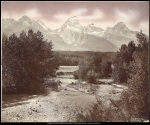This is a very interesting show done on the James brothers, Jesse and Frank. You can either view it on Hulu or view it here:
Archive for the ‘Biographies’ Category
Biography on Jesse and Frank James
Posted in 18th Century, American History, Biographies, Outlaws, tagged Frank James, Jesse James on May 12, 2009| 2 Comments »
His Promised Land: The story of John P. Parker
Posted in 19th Century, American History, Biographies, Books, Recommendations, tagged John P. Parker, runaways, slaves, Underground Railroad on November 14, 2008| Leave a Comment »
The book itself read more like a novel than an autobiography and kept my interest the entire way. Parker recalls some of the first hand accounts he experienced of smuggling runaway slaves and several of the dangers he faced while doing so — even the risk posed to his own freedom.
Wikipedia has some more basic information about him, but I highly recommend reading the book for anyone interested in this era of history.
The Hanging Judge
Posted in 19th Century, American History, Biographies, Lawmen, tagged American West, Executions, Hanging, Judge on May 16, 2008| 4 Comments »
“I have ever had the single aim of justice in view… ‘Do equal and exact justice,’ is my motto, and I have often said to the grand jury, ‘Permit no innocent man to be punished, but let no guilty man escape.'”
 Few judges in American history have such a reputation as that of Isaac Parker. Known as “The Hanging Judge,” Judge Parker sentenced more than 160 criminals (156 men and 4 women) to death by hanging and tried a total of 13,490 cases in only 21 years on the bench.
Few judges in American history have such a reputation as that of Isaac Parker. Known as “The Hanging Judge,” Judge Parker sentenced more than 160 criminals (156 men and 4 women) to death by hanging and tried a total of 13,490 cases in only 21 years on the bench.
Isaac Parker was born in Ohio on October 15, 1838. He grew up on a farm, but quickly discovered he had no interest in the farm life. When he wasn’t needed on the farm, he went school at the Breeze Hill primary school. After completing primary school, Parker attended the Barnesville Classical Institute which was a private institution. In order to earn money to pay for his schooling, he worked as a teacher at a county primary school. As early as the age of 17, Parker opted to study law. His study of law consisted of a combination of self-study and an apprenticeship. He passed the bar exam in 1859 after reading law with a Barnesville attorney.
After passing his bar exam, Parker moved west to St. Joseph, Missouri — a town later made famous by the infamous Jesse James. He began his legal career with the firm of Shannon and Branch which was operated by his uncle, D.E. Shannon. In 1861, after working on his own for a short while, he was elected to city attorney as a Democrat. On December 12th of the same year, he married Mary O’Toole. The couple eventually had two children: Charles and James.
After three years as a Democratic city attorney, he formally split from the Democratic party and ran for county prosecutor for the Ninth Missouri Judicial District as a Republican. That fall, he served as a member of the Electoral College and cast his vote for Abraham Lincoln. Four years later, in 1868, he won his first position as a judge. Parker won a six-year term as judge for the Twelfth Missouri Circuit, although he did not finish his term.
 1870 saw a different turn in Parker’s career. On September 13, 1870, he was nominated as a Republican candidate for the Seventh Congressional District in Missouri. After resigning his post as judge in favor of putting more energy into his campaign, he easily won the election on November 8th after his opponent had dropped out of the race. He easily won re-election for a second term two years later. During his second term, he gained national attention for his support of legislation for the rights and fair treatment of Indian tribes in the Indian Territory, or what is now Oklahoma. In 1874, however, the political landscape in Missouri had changed and as a Republican, Parker stood no chance of winning the election again. Instead he sought a presidential appointment to public office.
1870 saw a different turn in Parker’s career. On September 13, 1870, he was nominated as a Republican candidate for the Seventh Congressional District in Missouri. After resigning his post as judge in favor of putting more energy into his campaign, he easily won the election on November 8th after his opponent had dropped out of the race. He easily won re-election for a second term two years later. During his second term, he gained national attention for his support of legislation for the rights and fair treatment of Indian tribes in the Indian Territory, or what is now Oklahoma. In 1874, however, the political landscape in Missouri had changed and as a Republican, Parker stood no chance of winning the election again. Instead he sought a presidential appointment to public office.
On March 18, 1875, Parker’s presidential appointment was granted. He was appointed by President Ulysses S. Grant to preside over the federal district court for the Western District of Arkansas as judge. With his court in Fort Smith on the border of Indian Territory and Arkansas, it was this post that would lead him to infamy. At the time of his appointment, Indian Territory was a vast area of chaos where outlaws ruled outside the jurisdiction of the “White Man’s Court.” Parker sought to bring this anarchy to an end.
Parker held court for the first time on May 10, 1875. He sentenced eight men to death after being found guilty of murder. During the following summer, he would convict 15 people of murder and sentence eight of them to die by hanging on September 3rd of the same year. The sentence of one of the convicts was reduced to life in prison because of his young age and another convict was killed while attempting to escape.
The hangings of September 3rd gained national attention. Newspapermen traveled from all over the nation to attend the execution of the six men. Three of the felons were white, two of them Native American and one of them black. That morning, they were led to the gallows in front of a large crowd of spectators. As they sat at the back of the gallows, they were read their death warrants and asked if they had any last words.  After the preliminaries had finished, they were led up to the scaffolding and nooses were placed around their necks by executioner George Maledon (pictured right). The trap was sprung and the six men died instantly at the end of the ropes.
After the preliminaries had finished, they were led up to the scaffolding and nooses were placed around their necks by executioner George Maledon (pictured right). The trap was sprung and the six men died instantly at the end of the ropes.
The September 3rd hangings gave Judge Parker the nickname “The Hanging Judge” and were a sign that the times of the rule of outlaws in Indian Territory was at an end. His court was condemned by his critics as the “Court of the Damned.” By the time his career was over, there would be 73 more hangings.
Sick from a life of overworking and spending his last few days bedridden, Parker died of a heart attack on November 17, 1896.
Savage Photography
Posted in 19th Century, American History, Biographies, tagged American West, C.R. Savage, History of Photography, Photography on May 6, 2008| 2 Comments »
In 1860, a man by the name of Charles Roscoe Savage arrived with his family in the city of Salt Lake City, Utah. It was here that he would found his photography studio and begin capturing the wild American west in photographs. The medium of photography as a means of art or even as a means of documentation had of yet not been extensively used, however, Savage blazed new trails with his photographs of the yet vastly untouched American west.
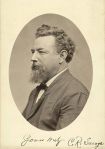 Charles Roscoe Savage (also known as C.R. Savage) was born in Southampton, England, on August 16, 1832. At the young age of 14, he joined the The Church of Jesus Christ of Latter-day Saints which is presumably the reason for his eventual emigration to Utah. During the winter of 1856-57, he emigrated to New York where he worked for a short time as a photographer, however, he soon relocated to Florence, Nebraska on assignment from the church. His family quickly joined him there. Relocating to Iowa soon after his move to Nebraska, he founded his first independent photography studio and gallery in Council Bluffs, Iowa.
Charles Roscoe Savage (also known as C.R. Savage) was born in Southampton, England, on August 16, 1832. At the young age of 14, he joined the The Church of Jesus Christ of Latter-day Saints which is presumably the reason for his eventual emigration to Utah. During the winter of 1856-57, he emigrated to New York where he worked for a short time as a photographer, however, he soon relocated to Florence, Nebraska on assignment from the church. His family quickly joined him there. Relocating to Iowa soon after his move to Nebraska, he founded his first independent photography studio and gallery in Council Bluffs, Iowa.
In August 1860, he traveled with his family to Salt Lake City, Utah where he established a new photography studio and gallery with a man by the name of Marsena Cannon who was a daguerreotype photographer. After Cannon left Salt Lake City, Savage formed a new partnership with George Martin Ottinger. Many of Savage’s photographs were printed in the Harper’s Weekly newspaper gaining him and the firm national attention. 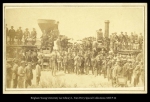 During this time Savage also worked under contract for the Union Pacific Railroad. He traveled to California in 1866 and photographed the progress as he followed the rails back east towards Utah. Some of his most famous photographs are photographs of the linking of the Union Pacific and the Central Pacific railroads at Promontory Summit in Promontory, Utah in 1869 (pictured right). Savage also took photographs of Yellowstone National Park and Zion National Park among many other places. In 1870, Savage and Ottinger dissolved their firm and Savage formed the Pioneer Art Gallery which was subsequently replaced by the Art Bazaar in 1875 after deciding he needed more room.
During this time Savage also worked under contract for the Union Pacific Railroad. He traveled to California in 1866 and photographed the progress as he followed the rails back east towards Utah. Some of his most famous photographs are photographs of the linking of the Union Pacific and the Central Pacific railroads at Promontory Summit in Promontory, Utah in 1869 (pictured right). Savage also took photographs of Yellowstone National Park and Zion National Park among many other places. In 1870, Savage and Ottinger dissolved their firm and Savage formed the Pioneer Art Gallery which was subsequently replaced by the Art Bazaar in 1875 after deciding he needed more room.
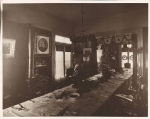 On June 26, 1883, Savage’s Art Bazaar burnt to the ground and with it took the negatives of his photographs. Savage died on Februrary 3, 1909 and two years later in 1911, another devastating fire destroyed the remaining negatives taken between the first fire and his death. The Art Bazaar permanently closed on December 31, 1926 after being run by his sons for several years.
On June 26, 1883, Savage’s Art Bazaar burnt to the ground and with it took the negatives of his photographs. Savage died on Februrary 3, 1909 and two years later in 1911, another devastating fire destroyed the remaining negatives taken between the first fire and his death. The Art Bazaar permanently closed on December 31, 1926 after being run by his sons for several years.
An extensive gallery of photographs taken by C.R. Savage is available online at the C.R. Savage Collection at Brigham Young University.
The Death of Doc Holliday
Posted in 19th Century, American History, Biographies, Outlaws, tagged American West, Doc Holliday, History, Wild West on May 5, 2008| 1 Comment »
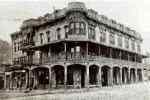 The year is 1887. Winter is beginning to grip its icy grip on the small mountain town of Glenwood Springs, Colorado. You’ve just arrived after a long journey by horse from Denver. Running inside from the chilly November air outside, you seek warmth in the lobby of the fashionable Hotel Glenwood where you engage a room for the night. As you walk tiredly to your room, you pass a room in which a sick man lays coughing. You hear the coughing even as you enter your own room and close the door. You can’t help but think that the man probably has consumption — a disease which plagued many in the 19th century.
The year is 1887. Winter is beginning to grip its icy grip on the small mountain town of Glenwood Springs, Colorado. You’ve just arrived after a long journey by horse from Denver. Running inside from the chilly November air outside, you seek warmth in the lobby of the fashionable Hotel Glenwood where you engage a room for the night. As you walk tiredly to your room, you pass a room in which a sick man lays coughing. You hear the coughing even as you enter your own room and close the door. You can’t help but think that the man probably has consumption — a disease which plagued many in the 19th century.
The sick man in the other room is Doc Holliday. A notorious and feared gunfighter and a man whose name is almost synonymous with the wild west outlaw, Doc Holliday’s death was melodramatic at best. His profession was dentistry, but his occupation was killing, gambling and drinking.
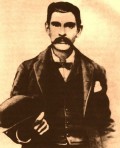 Doc Holliday was diagnosed with consumption, or tuberculosis as the disease is known now, shortly after his graduation from the Pennsylvania School of Dental Surgery in 1872 when he was 20. His mother had died of consumption 6 years prior in 1866 and it is widely assumed that Doc Holliday contracted the disease from his mother, although it is not known for certain. After a very short and generally unsuccessful attempt at professional dentistry, a sick Doc Holliday headed west from his native Georgia to find a drier climate. In Dallas, Texas, he gave dentistry another chance, but quickly found that his true calling was gambling where he found he could earn a much larger income. He also decided that death by bullet or by knife was better than death by consumption.
Doc Holliday was diagnosed with consumption, or tuberculosis as the disease is known now, shortly after his graduation from the Pennsylvania School of Dental Surgery in 1872 when he was 20. His mother had died of consumption 6 years prior in 1866 and it is widely assumed that Doc Holliday contracted the disease from his mother, although it is not known for certain. After a very short and generally unsuccessful attempt at professional dentistry, a sick Doc Holliday headed west from his native Georgia to find a drier climate. In Dallas, Texas, he gave dentistry another chance, but quickly found that his true calling was gambling where he found he could earn a much larger income. He also decided that death by bullet or by knife was better than death by consumption.
Throughout the remainder of his life, he drifted throughout the west leaving behind a reputation for his deadly shooting accuracy.  The Doc participated in several gunfights — the most famous of which was the gunfight at OK Corral in Tombstone, Arizona with the Earp brothers — and sent many other men to their graves. Eventually he settled for a short while in the mountain town of Leadville, Colorado until his failing health caused him to move to Denver where it was warmer in the winter of 1885. However, Doc Holliday’s stay in Denver was also short lived. In May 1887, he moved to Glenwood Springs, Colorado to take advantage of the natural springs that would presumably help his ailing body.
The Doc participated in several gunfights — the most famous of which was the gunfight at OK Corral in Tombstone, Arizona with the Earp brothers — and sent many other men to their graves. Eventually he settled for a short while in the mountain town of Leadville, Colorado until his failing health caused him to move to Denver where it was warmer in the winter of 1885. However, Doc Holliday’s stay in Denver was also short lived. In May 1887, he moved to Glenwood Springs, Colorado to take advantage of the natural springs that would presumably help his ailing body.
He checked into the Hotel Glenwood. His health continued to quickly deteriorate and he spent the last fifty-seven days of his life in bed in that hotel. Doc Holliday died on the morning of November 8, 1887. That morning, he allegedly asked for a final glass of whiskey before dying. Legend also has it that he looked down at his bare feet and said, “This is funny,” although many historians consider this unlikely as he would have been too sick on the day of his death for coherent speech. Irregardless of what he may or may not have said, no one ever expected that the infamous deadly gunfighter would die in bed with his boots off.



